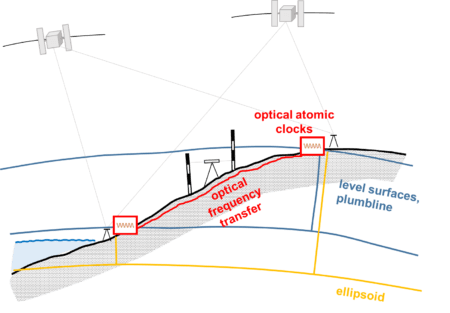Optical Atomic Clocks
At present, the use of optical atomic clocks for geodetic observations and geodetic networks is in an experimental stage. However, it could become a very important operational technique in the future. Experimental atomic clocks (or frequency standards) in metrology laboratories today provide extremely precise frequencies based on a rich variety of energy transitions in different atomic species. The experiments make use of sophisticated quantum metrology procedures. Evaluations of the frequency measurements show mind-blowing precision with relative frequency inaccuracies that are currently at the level of 10-18 only, making the measurements the most precise of any physical quantity.
Determination of potential differences by comparing frequencies of optical atomic clocks located at different heights.
When frequencies generated by clocks at different sites are compared at this level of precision (10-18), the comparison contains the relativistic gravitational frequency redshift due to the different height (and gravity potential) of the sites, as described by General Relativity. Today, the most accurate frequency transfer between sites is by phase-stabilized optical fiber, which has been demonstrated to work on continental scale without loss of precision (see figure above). In the future, also optical frequency transfer through satellites will be a candidate technology. Remote frequency comparisons are essential for the preparation of a re-definition of the second (as an unit of the International System of Units) that is currently ongoing led by the Consultative Committee on Time and Frequency (CCTF, https://www.bipm.org/en/committees/cc/cctf) of the Bureau International des Poids et Mesures (BIPM).
Chronometric Leveling
On the other hand, the measurement of the frequency redshift between sites makes chronometric leveling possible by converting frequency differences to height differences and gravity potential differences. The results of chronometric leveling are comparable to the determination of height and potential differences by classical methods such as first order spirit leveling or the gravimetric GNSS/geoid approach. The fascination and important strength of the relativistic approach is, however, that it is a much more direct measurement technique and immediately based on atomic standards. For future continental or global height systems, it is expected that the relativistic method in combination with the classical approaches will provide a much more clearly defined, homogeneous, stable and accessible reference.
In recent years, successful long-distance optical comparisons of optical atomic clocks have been demonstrated between the metrology laboratories PTB (Braunschweig, Germany), Observatoire de Paris (Paris) and NPL (London) (see https://doi.org/10.1038/ncomms12443). The results between PTB and Observatoire de Paris so far correspond to a few decimeters accuracy in height difference. In 2019, in a very promising experiment using the world’s best transportable optical atomic clocks, chronometric leveling has been demonstrated to an accuracy of 4 cm over a height difference of 450 m at the Tokyo SkyTree tower (see https://doi.org/10.1038/s41566-020-0619-8). At present, remote frequency comparisons are addressed in numerous international research projects in the time and frequency metrology community.



